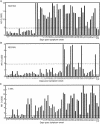Immunoassay targeting nonstructural protein 5 to differentiate West Nile virus infection from dengue and St. Louis encephalitis virus infections and from flavivirus vaccination
- PMID: 12958248
- PMCID: PMC193845
- DOI: 10.1128/JCM.41.9.4217-4223.2003
Immunoassay targeting nonstructural protein 5 to differentiate West Nile virus infection from dengue and St. Louis encephalitis virus infections and from flavivirus vaccination
Abstract
West Nile virus (WNV) is an emerging flavivirus that has caused frequent epidemics since 1996. Besides natural transmission by mosquitoes, WNV can also be transmitted through blood transfusion and organ transplantation, thus heightening the urgency of development of a specific and rapid serologic assay of WNV infection. The current immunoassays lack specificity because they are based on detection of antibodies against WNV structural proteins and immune responses to structural proteins among flaviviruses cross-react to each other. Here, we describe microsphere immunoassays that detect antibodies to nonstructural proteins 3 and 5 (NS3 and NS5). In contrast to immunoassays based on viral envelope and NS3 proteins, the NS5-based assay (i) reliably discriminates between WNV infections and dengue virus or St. Louis encephalitis virus infections, (ii) differentiates between flavivirus vaccination and natural WNV infection, and (iii) indicates recent infections. These unique features of the NS5-based immunoassay will be very useful for both clinical and veterinary diagnosis of WNV infection.
Figures



References
-
- Ackermann, M., and R. Padmanabhan. 2001. De novo synthesis of RNA by the dengue virus RNA-dependent RNA polymerase exhibits temperature dependence at the initiation but not elongation phase. J. Biol. Chem. 276:39926-39937. - PubMed
-
- Brinton, M. A. 2002. The molecular biology of West Nile virus: a new invader of the Western hemisphere. Annu. Rev. Microbiol. 56:371-402. - PubMed
-
- Burke, D. S., and T. P. Monath. 2001. Flaviviruses, p. 1043-1126. In D. M. Knipe and P. M. Howley (ed.), Fields virology, 4th ed. Lippincott Williams & Wilkins, Philadelphia, Pa.
-
- Centers for Disease Control and Prevention. 1993. Inactivated Japanese encephalitis virus vaccine. Recommendations of the Advisory Committee on Immunization Practices (ACIP). Morb. Mortal. Wkly. Rep. 42(RR-1):1-15. - PubMed
Publication types
MeSH terms
Substances
Grants and funding
LinkOut - more resources
Full Text Sources
Other Literature Sources
Medical
Research Materials

